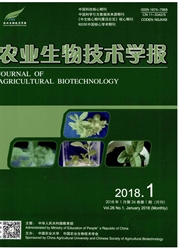

 中文摘要:
中文摘要:
S-位点受体激酶(SRK)和S-位点半胱氨酸富集蛋白(SCRl是自交不亲和反应中雌、雄性决定因子,两者是受体与配体关系,相互作用具有单倍型特异性。为建立适于SRK与SCR单倍型特异性识别及作用机理研究的技术体系,本研究以甘蓝(Brassica oleraceaL.)高代自交系E、F为材料,首先,采用亲和指数法测定两种材料的亲和性,结果表明,E、F为强自交不亲和系,两者间异交亲和;其次,从E、F材料gDNA中扩增eSRKE、eSRKF、SCRE和SCRF基因编码序列,同源比对表明,E为S28单倍型、F为S7单倍型;再次,利用酵母双杂交Gold系统检测eSRKE、eSRKF和SCRE、SCRF间的相互作用,结果显示,eSRKE与SCRE、eSRKF与SCRF之间作用,eSRKE与SCRF、eSRKF与SC风之间不能作用,这与利用亲和指数法检测的结果完全一致。研究结果建立了为进一步探索SCR与SRK的识别与作用机理的技术体系。
 英文摘要:
英文摘要:
S-locus receptor kinase (SRK) and S-locus cysteine rich protein (SCR) are determinant factors of male and female in self-incompatibility, they are receptor-ligand relation and act with each other in allele-specific manner. To establish a technology system suitable for analysis of the allele-specific recognition and interaction mechanism between SRK and SCR, Brassica oleracea L. inbred lines E and F were used as plant materials. Firstly, the compatible index were analyzed by pollination assay, the result showed that E and F were all self-incompatible lines, they belonged to different haplotypes and their cross-pollination were compatible. Secondly, eSRKE, eSRKF, SCRE and SCRF were cloned from genomic DNA (gDNA) of E and F,nucleotide Blast revealed that E was S~ haplotype, and F was S7 haplotype. Thirdly, the interactions among the SCRE, SCRF, eSRKE and eSRKF were detected by MatchmakerTM Gold yeast two-hybrid system. The results indicated that SCRE could specific interact with eSRKE, SCRF could specific interact with eSRKF, whereas SCRF could not interact with eSRKE and SCRE could not interact with eSRKF, which were in entirely agreement with the result of pollination assay. The analysis of the interaction SCRE, SCRF, eSRKE and eSRKF provides a technology system for further study on recognition and interaction mechanism between SRK and SCR.
 同期刊论文项目
同期刊论文项目
 同项目期刊论文
同项目期刊论文
 期刊信息
期刊信息
